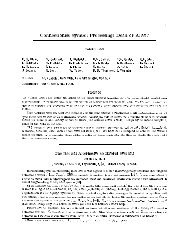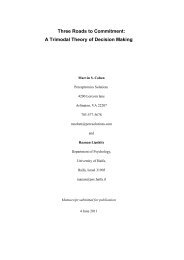Three Roads to Commitment: A Trimodal Theory of Decision Making
Three Roads to Commitment: A Trimodal Theory of Decision Making
Three Roads to Commitment: A Trimodal Theory of Decision Making
Create successful ePaper yourself
Turn your PDF publications into a flip-book with our unique Google optimized e-Paper software.
<strong>Three</strong> <strong>Roads</strong> <strong>to</strong> <strong>Commitment</strong>: A <strong>Trimodal</strong> <strong>Theory</strong> <strong>of</strong> <strong>Decision</strong> <strong>Making</strong> 31<br />
for a matching problem-solution pair, rather than a propositional argument from problem <strong>to</strong> solution.” These issues<br />
are addressed more formally in the discussion <strong>of</strong> assumption-based reasoning in the next section.<br />
ACTION UNCERTAINTY<br />
Uncertainty plays a central role in both the standard s<strong>to</strong>ry and in alternative models (Smithson, 1989); the<br />
broken lines and ovals in Figure 3 and Figure 4 illustrate some <strong>of</strong> the problems that uncertainty poses in real-world<br />
decision making. Statistical approaches generally utilize measures derived from probability (e.g., resolution is<br />
lowest when probabilities are furthest from zero or one; entropy is maximum for n possibilities when the chance <strong>of</strong><br />
each is 1/n). Probabilities, however, have an explicit application only <strong>to</strong> choice, where uncertainty about outcomes<br />
figures in calculations <strong>of</strong> the optimal course <strong>of</strong> action. Even in choice, probabilities do not reflect the amount <strong>of</strong><br />
knowledge or lack <strong>of</strong> knowledge underlying the specification <strong>of</strong> problem elements: courses <strong>of</strong> action, values, or<br />
roles, the events and outcomes <strong>to</strong> which probabilities are applied, or the probabilities themselves (Langlois &<br />
Cosgel, 1992; Cohen, Schum, Freeling, & Chinnis, 1984; Cohen, Laskey, Chinnis, Ulvila, 1986). Moreover,<br />
reducing uncertainty <strong>to</strong> a single quantitative dimension overlooks qualitative differences in uncertainty types and in<br />
the methods enlisted for handling them (Cohen et al, 1996; Lipshitz & Strauss, 1997). The kind <strong>of</strong> uncertainty we<br />
are interested in is pragmatic (i.e., relevant <strong>to</strong> difficulty in arriving at commitment), differentiated (i.e., provides<br />
qualitative guidance for decision making strategies), and general (i.e., not tied exclusively <strong>to</strong> choice). To distinguish<br />
it from other senses, we will refer <strong>to</strong> this concept as action uncertainty.<br />
Affordance for <strong>Commitment</strong><br />
Uncertainty in the standard s<strong>to</strong>ry (i.e., probability) has both subjective and objective senses (Gillies, 2000). If<br />
subjective, it is a property <strong>of</strong> the decision maker (e.g., personal betting odds in Bayesian statistics); if objective, it is<br />
a property <strong>of</strong> the environment (e.g., symmetries or relative frequencies in a sample space). In either case, uncertainty<br />
has a particular locus (in the decision maker’s head or in the environment, respectively), describes a state that exists<br />
at a particular time, and has a value that can change only as the decision maker’s knowledge or the physical<br />
arrangement <strong>of</strong> the environment, respectively, changes. We intend <strong>to</strong> challenge this conception: it cannot satisfy the<br />
pragmatic condition on action uncertainty, that it correlate with the difficulty <strong>of</strong> decision making. In its place, TDM<br />
supplies an ecological concept, which (i) includes both the decision maker and the environment, and (ii) captures<br />
prospective outcomes <strong>of</strong> decision making over time extending from the present. An example will illustrate.<br />
Suppose Dr. House intends <strong>to</strong> administer a lengthy treatment process, A, <strong>to</strong> a particular patient, with many steps




